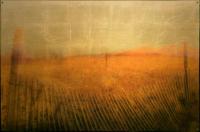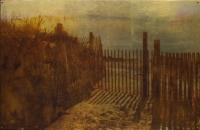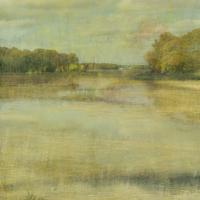The landscapes between photography and painting by Dorothy Simpson Krause
FB: Once you said that digital manipulation of images opens the same opportunities that programs text gave to writers: the chance to correct and edit their text until they reach the desired result. This means that in your work do you start from a precise idea, or if you want inspiration, and begin to pull it out gradually, as sculptures digging in a block of marble? Or is the serendipidity an important part of your work, you experiment leaving the image evolving until the case does play its game?
DSK: I usually work in series and have a sense of what I want to use for imagery and how I want to print the images but serendipity plays a huge part in my work with many “happy accidents” leading to interesting final work.
For example, Studs was printed onto a sheet of old patinaed copper, nailed to a 24” square plywood panel using the Durst Rho160W flat-bed printer. Since the Durst uses white ink, a “mask” was made for printing white spot-color and gradations. In the final print, the copper is clearly visible where ink was minimal and, in some areas, the copper is completely covered by the highly pigmented color on top of the white UV ink. Actual nails enhanced with black wax and silver pigment were nailed into the plywood/ copper surface of the print.
If things don’t work as expected, I paint over or sand off the surface or put the piece away for another use at another time.
FB: But let go back to the use of computers in art. Another reason being cited to justify the rejection of their use is that they are aseptic, cold, rational and really abstract instruments. Sometimes it’s nice to step back to the manual aspect of hand made objects, the interaction with raw materials, the contact with reality. In my case for example, I shoot and edit digitally, because this freedom of expression is now irreplaceable for me, but then I print a large fraction of my photographies in the darkroom using historical processes. In addition to the final result, the contact with materials gives me a purely physical pleasure. In your case you use a mixture of advanced technology and simple and humble materials, hand painted inkjet prints, collage, etc. Do you share the need of a direct contact with objects? Is it purely related to the final result, or you have another exigence?
DSK: It’s not the tool but how you choose to use it that creates the final result. I dislike the flat quality some straight prints on paper but the possibilities for combining materials and processes are endless and seductive.
To read the rest of this article go to page: 1 2 3 4 5






